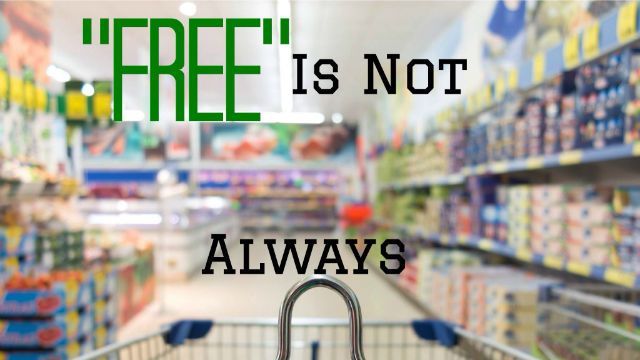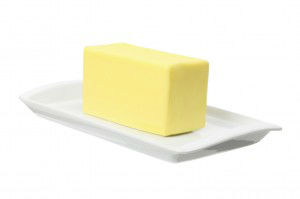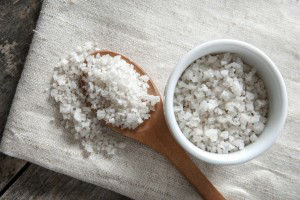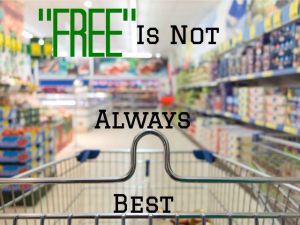
When we see the word “free,” we instinctively get excited thinking it must be a great thing. However, the reality is that there are very few things in life that are truly “free.” There is almost always a cost, whether it be monetary or otherwise. In the case of “free” foods, the cost is your health.
Manufacturers would like us to believe that “free” is best and worth even the extra money it may cost. The insinuation here is that “free” foods are healthier than their “non-free” counterparts. That somehow removing something deemed to be bad for our health makes its replacement automatically good for us.
The problem with this, however, is twofold. Firstly, these “free” foods that we are talking about are not whole foods but rather packaged and processed foods that have very little that is worthwhile in them to begin with. Secondly, most of the time, when something is removed from a food, something else takes its place, and that something else is oftentimes worse than what was taken out.
So, this is a quandary for sure. We are drawn to the “free” label because we have been conditioned – even brainwashed – by fancy million-dollar marketing schematics featuring empty promises spoken by attractive and fit people who supposedly eat loads of “free” food and still look awesome.
Maybe you are concerned about your health and making the right decisions, but are inundated with so much conflicting information on a daily basis regarding what you should and should not eat that you feel yourself spinning in a circle. We feel your pain and want to help clear up any confusion.
You have to eat, that is a given. The human body is designed to operate on the fuel we provide. However, that food needs to be whole and nutritious, not the result of a laboratory experiment. This “free” food we speak of was not harvested from the ground or grown on a tree, but is the end result of a complex string of chemical formulations.
The cost for buying into the the “free” food mentality is bigger than you may think. In the end, these foods are nothing close to free, and may cost you the health that you are trying so hard to achieve.
Here are 5 “free” food types that you should be extremely cautious of.
Sugar-free foods
Would you be surprised if we told you that of the 600,000 or so foods that are manufactured and consumed in the United States, over 80 percent of them contain added sugar?
As you may well know, the side effects of sugar are damaging, even deadly, and include such things as a suppressed immune system, elevated blood sugar, disrupted digestion, tooth decay and obesity.
 Now, having said that, you may be thinking… sugar-free is the way to go. However, we urge you to approach this thought with caution.
Now, having said that, you may be thinking… sugar-free is the way to go. However, we urge you to approach this thought with caution.
Every time you dive into a product that claims to be sugar-free but is surprisingly, sometimes sickeningly, sweet, you are most likely consuming an artificial sweetener. Just the word “artificial” should raise some concern. Artificial means, quite simply, that a substance was concocted in a laboratory by humans in a non-natural manner.
Artificial sweeteners have been around for a very long time. Who could forget Tab, the cola made by Coca Cola Company which was popular in the 1960s and 70s? After it was discovered that the soda contained sodium saccharin, a controversial coal tar derivative, sales dropped.
The main ingredient in this sulfa-based sweetener is benzoic sulfimide. Persons with sulfa allergies may experience nausea, diarrhea or other allergy-related symptoms upon ingestion. Although early animal studies linked saccharin (sold as Sweet’N Low) with bladder cancer, the FDA removed mandatory health warnings in 2000.
Sucralose is another popular artificial sweetener that is marketed as Splenda, Sukrana, SucraPlus, Candys, Nevella and Cukren. Scientists in search of new insecticides accidentally discovered this sweetener in 1976.
Used in over 4,500 food and beverage products, mostly cereal, candy and sodas, sucralose – a supposedly inert chemical – may promote the onset of type 2 diabetes, and the Center for Public Interest (CSPI) has recently reduced its safety rating from This downgrade follows an Italian study which linked sucralose consumption to an increased risk of leukemia in lab animals.
Marketing material for aspartame tells us that this low-cal sweetener, known as NutraSweet, is harmless, and in fact, acts the same way in our body as other protein foods. However, a little investigation reveals something quite different.
Aspartame is linked to many negative health effects, including behavior changes, and has the properties of a neurotoxin. After the FDA received over 8,000 complaints on the side effects it leased a list of all 92 adverse effects associated with cosumption including headaches, seizures, failed kidney function and even cancer.
Action: Be sure that you check labels very carefully; it is likely that if a packaged and processed food makes the bold claim to be sugar-free and is actually sweet – something unsafe has been added. Best to stick to naturally sweet foods and use real sweeteners like raw honey and coconut crystals when you want additional sweetness.
Saturated fat-free foods
The time for bashing foods rich in natural fat is slowly coming to end. Finally, researchers are beginning to reveal just what a hoax the entire lipid hypothesis really was. This hypothesis stated that there was an intimate relationship between saturated fat, cholesterol and heart disease.
Fat bashing began in the 1950s, and by the 80s there was a serious push away from animal fats towards synthetic fats. This hypothesis was built on questionable evidence at best. Ancel Keys, the founder of the hypothesis, presented his “findings” to the medical community. Despite the lack of evidence and the prevalence of other studies finding different conclusions, the lipid hypothesis took fire.
 Most of the fuel came from the food manufacturers and vegetable oil producers who saw great benefit in riding on this hypothesis. If everyone would stop using saturated fat, they could convince them that refined vegetable oil was healthy.
Most of the fuel came from the food manufacturers and vegetable oil producers who saw great benefit in riding on this hypothesis. If everyone would stop using saturated fat, they could convince them that refined vegetable oil was healthy.
The truth is, almost 90 percent of all well-researched studies examining this hypothesis do not support the fact that saturated fats and dietary cholesterol cause heart disease. It’s no secret that humans need to eat fats to survive.
Fat produces energy and aids in the absorption of vitamins and minerals. However, it’s also no secret that too much fat, and especially too much of the wrong types of fat, can be deadly.
Like sugar-free foods, fat-free foods are far from trouble-free, and are laden with synthetic fats that have now been proven to be highly dangerous to our health. In fact, if you are looking to normalize cholesterol levels and keep chronic conditions such as heart disease and diabetes at bay, fat-free is a far cry from the direction you should head.
The fat that needs to be avoided the most is trans fat, also known as partially hydrogenated oil. Often included in so-called “low fat” foods, this fake fat is highly dangerous. The main sources of trans fats are processed, baked goods and fast foods.
These types of fats raise levels of ‘bad’ LDL cholesterol, while reducing levels of ‘good’ HDL cholesterol. It is best to stay away from trans fats altogether, they offer absolutely no health benefits.
So, what about labels that say trans fat-free… are they safe? Well, no, not really. Trans fats actually hide behind a number of names, and sadly, many food labels that claim no trans fats still contain them, only under different names such as shortening, hydrogenated and partially hydrogenated oil, DATEM, mono and diglycerides.
This label loophole allows food manufacturers of such products as Triscuit Thin Chips and Land O’Lakes Buttery Spread to claim that they are trans fat free when they actually contain hydrogenated (GMO) oils. Hydrogenated oil even hides in Flintstones Vitamins, of all things.
Action: Be leery of labels that claim to be saturated fat free and trans fat free. Pay very close attention to what is actually in the food. Eat as few processed and packaged foods as possible and consume real fats such as those found in grass fed butter, coconut oil and grass fed meats.
Gluten-free foods
One of today’s most discussed health topics is a gluten-free lifestyle. More and more gluten-free products are popping up on the shelves, and the sales of gluten-free foods now gross over ten billion dollar per year. Many people are currently re-evaluating the role of wheat and other grains in their diets.
While only about one percent of the population suffer from serious gluten insensitivity, known as celiac disease, it is wise for all of us to be careful of wheat and wheat products. Wheat, like sugar, is pro-inflammatory in nature and will worsen any condition that has inflammation at its root.
So, if you have decided to take the big jump towards a gluten-free lifestyle, you may be instantly drawn to the scores of gluten-free products – new ones introduced daily – that line your grocer’s shelves.
Many stores have now dedicated entire sections to gluten-free foods, due mostly to their popularity. The gluten-free food industry, like the fat-free and sugar-free industries, has capitalized hugely on the recent surge of interest in a gluten-free lifestyle.
Yes, becoming gluten-free does mean giving up that Friday night pizza you have always enjoyed and the breakfast cereal that you really like, but… what it does not mean is just switching to buying a processed gluten-free pizza or boxed breakfast cereal with a gluten-free label slapped on the front. What is wrong with this, you might ask… after all, aren’t these products made with gluten-free ingredients?
Well, yes, and no. Many foods that claim to be gluten-free may actually still contain gluten. There is no current government regulation or enforcement regarding the labeling of these products, so manufacturers are really free to say what they want.
In 2013, the FDA did settle on a definition of gluten-free, which is 20 parts per million of gluten. However, there is no law that states that manufacturers must put a label on their food if it is gluten-free. Companies put gluten-free labels on their foods in an attempt to court business.
The big problem with most gluten-free foods is that they are still processed, packaged, refined and manufactured, and include everything from salad dressings to bread to candy. They are not whole foods loaded with vital nutrients that the body needs to function optimally. For instance, a bag of gluten-free cookies are still cookies – they are processed, still contain sugar and most likely trans fats.
Action: There are plenty of foods that are innately gluten free, whole foods like fruits, vegetables and grains and seeds like quinoa, rice, flax, oats and sorghum that can be enjoyed on a daily basis. Make your focus not so much on just buying gluten-free foods, but more on enjoying the foods that are purely gluten-free in nature.
Caffeine-free coffee
Decaffeinated drinks have been promoted as a healthy alternative for almost thirty years, however, they are often a great deal more dangerous than unmodified versions.
Interestingly enough, the whole idea of decaffeinated beverages is centered around the thought that caffeine, even in small doses, is unhealthy for us, which just is not true.
Caffeine has a natural stimulant effect on the central nervous system, which raises metabolism and increases the oxidation of fatty acids. It also mobilizes fatty acids from fat tissues, and there is good evidence that it increases athletic performance.
Type ll diabetes is skyrocketing in America and now afflicts almost 1 in 8 people. Coffee appears to do a good job regulating blood sugar. Numerous studies demonstrate that coffee has been associated with a 23 to 67 percent lower risk of diabetes.

Everyone knows that if you want to stay awake you drink coffee, right? Well, we bet you did not know that drinking coffee can also boost your brain power and your mood. Caffeine blocks the effects that the neurotransmitter adenosine has on the brain.
By doing so, the caffeine increases brain activity and the release of neurotransmitters such as dopamine and norepinephrine. Controlled trials have examined the effects that caffeine has on the brain, and have found that it improves mood, reaction time, memory and overall cognitive function.
Optimal liver function is vital to health. The results of our modern life, such as a poor diet and excessive alcohol consumption, cause the liver to work at less than full speed. Numerous studies have indicated that coffee can lower the risk of cirrhosis by up to 80 percent in people who drink 4 or more cups of coffee per day. Coffee may also reduce the risk of liver cancer by 40 percent.
Despite all this good, the decaffination of coffee was and continues to be a very big business. Early efforts to produce decaffeinated drinks were halted because toxic solvents including benzene, chloroform and trichloroethylene were used. Although, benzene is still in soft drinks such as Coke, Pepsi etc… and microwaved foods.
All it took was a little money from industry partners to buy FDA safety studies and decaffeination was back in business. At this point, it switched to the solvent dichloromethane because it was “lower toxicity.” However, after it was discovered that it too was carcinogenic, it was also done away with.
Today, there are three recognized methods of decaffeinating coffee; the chemical solvent method, the carbon dioxide method, and the Swiss water method. Although those in favor of the chemical solvent method will tell you that rinsing and steaming removes most of the chemicals, trace amounts are still found in the coffee, including ethyl acetate (a common chemical found in nail polish remover).
While caffeine consumption may raise your blood pressure for a short period of time, ingesting chemicals such as benzene, ethyl acetate and methylene chloride can possibly increase your risk of developing a serious medical condition – especially if you are not detoxing on a regular basis. The carbon dioxide method employs carbon dioxide at a very high atmospheric pressure. When coffee beans are exposed to this solvent, the caffeine dissolves into it.
The Swiss water method, previously thought to be a safe method of decaffeinating, is now coming under question. This method uses a coffee extract which is almost caffeine-free. The caffeine in green coffee beans migrates into the extract and leaves the flavor and decaffeinated coffee behind.
Action: For now, it is best to avoid all decaffeinated coffee, and stick to a moderate amount of organic regular coffee instead. Enjoy it with a scoop of coconut oil for a really delicious treat.
Salt-free foods
Sodium is one of those things that the government has been cautioning us about for decades, mostly because it is thought to increase blood pressure – a common risk factor for heart disease and stroke.
All the major health organizations state that we need to cut back on sodium, such as the United States Department of Agriculture, the American Heart Association, the American Diabetes Association and the Academy of Nutrition and Dietetics.
There is a general consensus amongst these groups that ¾ to 1 teaspoon of salt per day is all we should consume. However, the average intake of salt per day is about twice the recommended amount – mostly from processed foods.
Sodium is an electrolyte found in the body, and most foods contain small amounts naturally. However, most of the sodium in our diet comes from salt. Salt is 40 percent sodium and 60 percent chloride. Here is what may come as a surprise: we cannot live without sodium.
 Real and natural salt is as essential to life as water – without it we would die. Salt has been so valuable through history that it was even used as currency in Rome and traded by explorers throughout Europe and Africa for gold.
Real and natural salt is as essential to life as water – without it we would die. Salt has been so valuable through history that it was even used as currency in Rome and traded by explorers throughout Europe and Africa for gold.
- Unrefined, natural salt is vital to a number of biological functions, such as:
- Exporting nutrients to and from cells
- Keeping blood pressure stable
- Increasing brain cells that regulate long-term planning and creative thinking
- Assisting the brain in communicating with the muscles
There are a couple of things that you may not know. The first is that hypertension, which salt is all too commonly seen as causing, is much more frequently triggered by excess grain and fructose. Americans consume far more carbohydrates in the form of sugar and grain than they do salt.
While salt has been presented to the public as evil and unnecessary, the actual empirical evidence backing this up is slim at best. That leads to the second, not so commonly shared, fact: there are no real studies that demonstrate a link between heart disease and salt consumption.
Gary Taubes, an investigative reporter and author of the classic 1988 article, “The (Political) Science of Salt,” wrote:
“While the government has been denouncing salt as a health hazard for decades, no amount of scientific effort has been able to dispense with the suspicions that it is not. Indeed, the controversy over the benefits, if any, of salt reduction now constitutes one of the longest running, most vitriolic, and surreal disputes in all of the medicine…
The data supporting universal salt reduction have never been compelling, nor has it ever been demonstrated that such a program would not have unforeseen negative side effects. After decades of intensive research, the apparent benefits of avoiding salt have only diminished.
This suggests either that the true benefit has now been revealed and is indeed small, or that it is nonexistent, and researchers believing they have detected such benefits have been deluded by the confounding influences of other variables…”
The greatest irony of all is that too little sodium can cause a host of adverse effects, such as:
- Insulin resistance
- Increased LDL cholesterol and triglycerides
- Type 2 diabetes
- Hyponatremia
Sally Fallon Morell, president of the Weston A. Price Foundation, stated:
“A study from 1991 indicates that people need about one and one-half teaspoons of salt per day. Anything less triggers a cascade of hormones to recuperate sodium from the waste stream, hormones that make people vulnerable to heart disease and kidney problems. This is proven biochemistry. Yet, FDA as well as USDA want to mandate drastically restricted sodium consumption at about one-half teaspoon per day.”
Action: Eat real food, with real salt such as sea salt and Himalayan salt. Avoid processed, canned and packaged foods – mainly because they contain large amounts of refined salt and other ingredients that our body does not process well.
A free gift is nice if it is really free – no strings attached. While the best things in life are free, these five “free” foods are definitely worth reconsidering. Don’t forget to always read the fine print, and keep in mind that whole, organic foods are always best – the least tampered-with foods provide the body with the greatest source of nutrients, which translate into more energy and better health for you. Don’t be fooled – do your own research and make educated decisions regarding your health and the health of your family.
-The Alternative Daily


